Measuring Tendering and Estimating for Construction Report
VerifiedAdded on 2020/01/28
|15
|4032
|271
Report
AI Summary
This report delves into the critical aspects of measuring tendering and estimating within the construction and built environment sectors. It begins by examining the client's involvement in the tender-making process, analyzing constraints, and outlining essential contractual documentation. The report then explores the creation of unit rates, emphasizing data requirements, standard documentation, and method statements. It covers the bill of quantities, critical factors affecting profit margins, health and safety considerations, and cost/overhead calculations. Finally, it addresses open and selective tendering stages, factors for contractor selection, and different contract forms in construction. The report provides a comprehensive overview of the tendering and estimating process, offering valuable insights into the complexities of construction projects and the built environment.
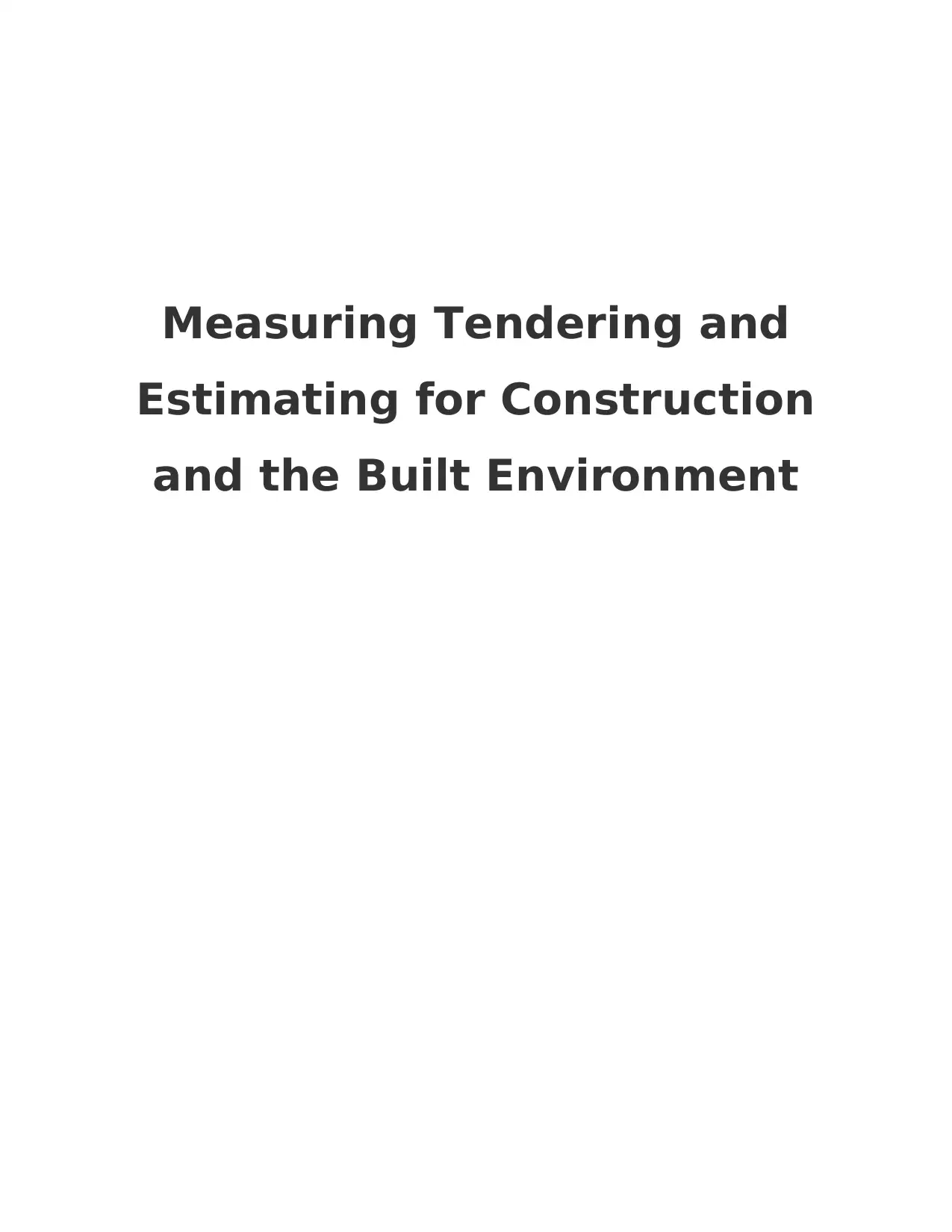
Measuring Tendering and
Estimating for Construction
and the Built Environment
Estimating for Construction
and the Built Environment
Paraphrase This Document
Need a fresh take? Get an instant paraphrase of this document with our AI Paraphraser
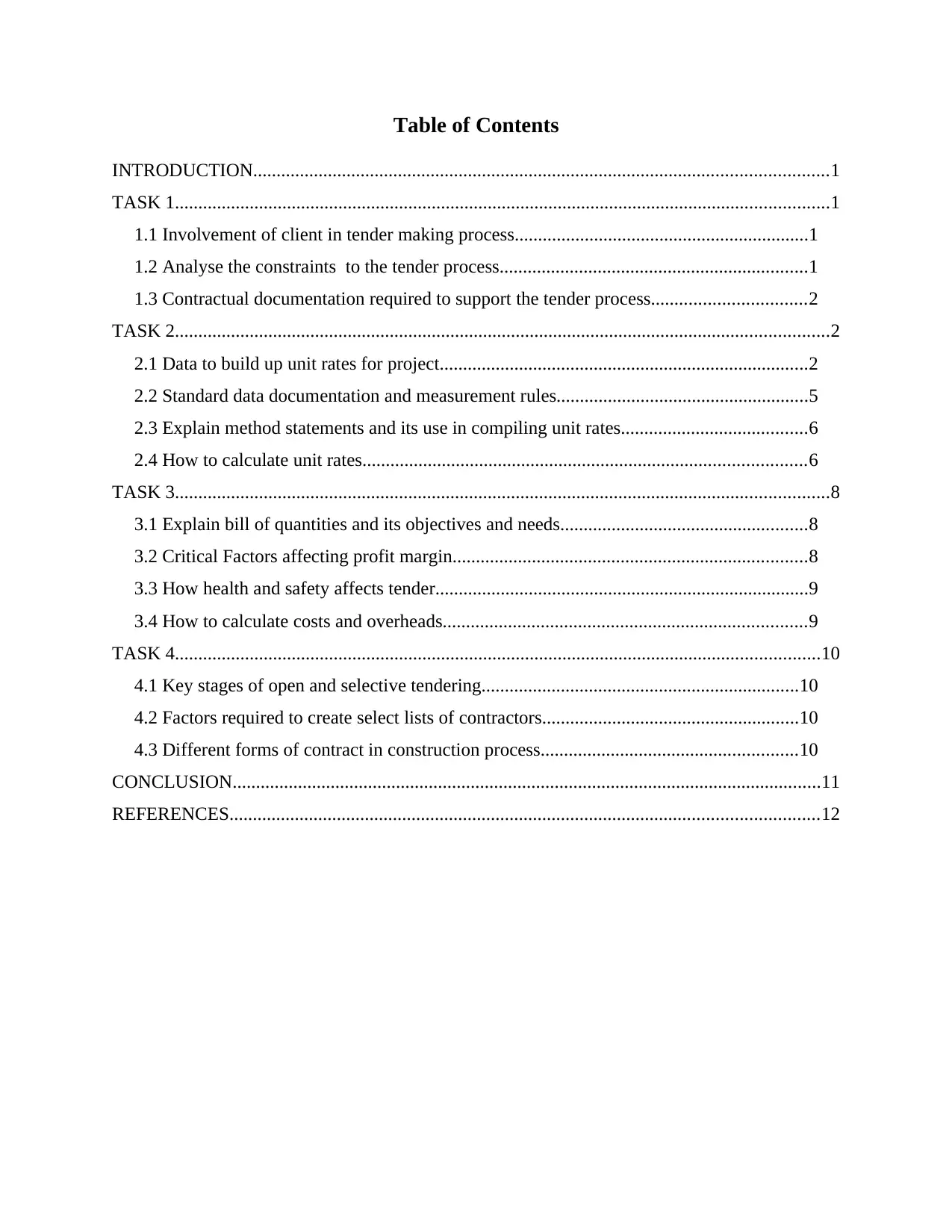
Table of Contents
INTRODUCTION...........................................................................................................................1
TASK 1............................................................................................................................................1
1.1 Involvement of client in tender making process...............................................................1
1.2 Analyse the constraints to the tender process..................................................................1
1.3 Contractual documentation required to support the tender process.................................2
TASK 2............................................................................................................................................2
2.1 Data to build up unit rates for project...............................................................................2
2.2 Standard data documentation and measurement rules......................................................5
2.3 Explain method statements and its use in compiling unit rates........................................6
2.4 How to calculate unit rates...............................................................................................6
TASK 3............................................................................................................................................8
3.1 Explain bill of quantities and its objectives and needs.....................................................8
3.2 Critical Factors affecting profit margin............................................................................8
3.3 How health and safety affects tender................................................................................9
3.4 How to calculate costs and overheads..............................................................................9
TASK 4..........................................................................................................................................10
4.1 Key stages of open and selective tendering....................................................................10
4.2 Factors required to create select lists of contractors.......................................................10
4.3 Different forms of contract in construction process.......................................................10
CONCLUSION..............................................................................................................................11
REFERENCES..............................................................................................................................12
INTRODUCTION...........................................................................................................................1
TASK 1............................................................................................................................................1
1.1 Involvement of client in tender making process...............................................................1
1.2 Analyse the constraints to the tender process..................................................................1
1.3 Contractual documentation required to support the tender process.................................2
TASK 2............................................................................................................................................2
2.1 Data to build up unit rates for project...............................................................................2
2.2 Standard data documentation and measurement rules......................................................5
2.3 Explain method statements and its use in compiling unit rates........................................6
2.4 How to calculate unit rates...............................................................................................6
TASK 3............................................................................................................................................8
3.1 Explain bill of quantities and its objectives and needs.....................................................8
3.2 Critical Factors affecting profit margin............................................................................8
3.3 How health and safety affects tender................................................................................9
3.4 How to calculate costs and overheads..............................................................................9
TASK 4..........................................................................................................................................10
4.1 Key stages of open and selective tendering....................................................................10
4.2 Factors required to create select lists of contractors.......................................................10
4.3 Different forms of contract in construction process.......................................................10
CONCLUSION..............................................................................................................................11
REFERENCES..............................................................................................................................12
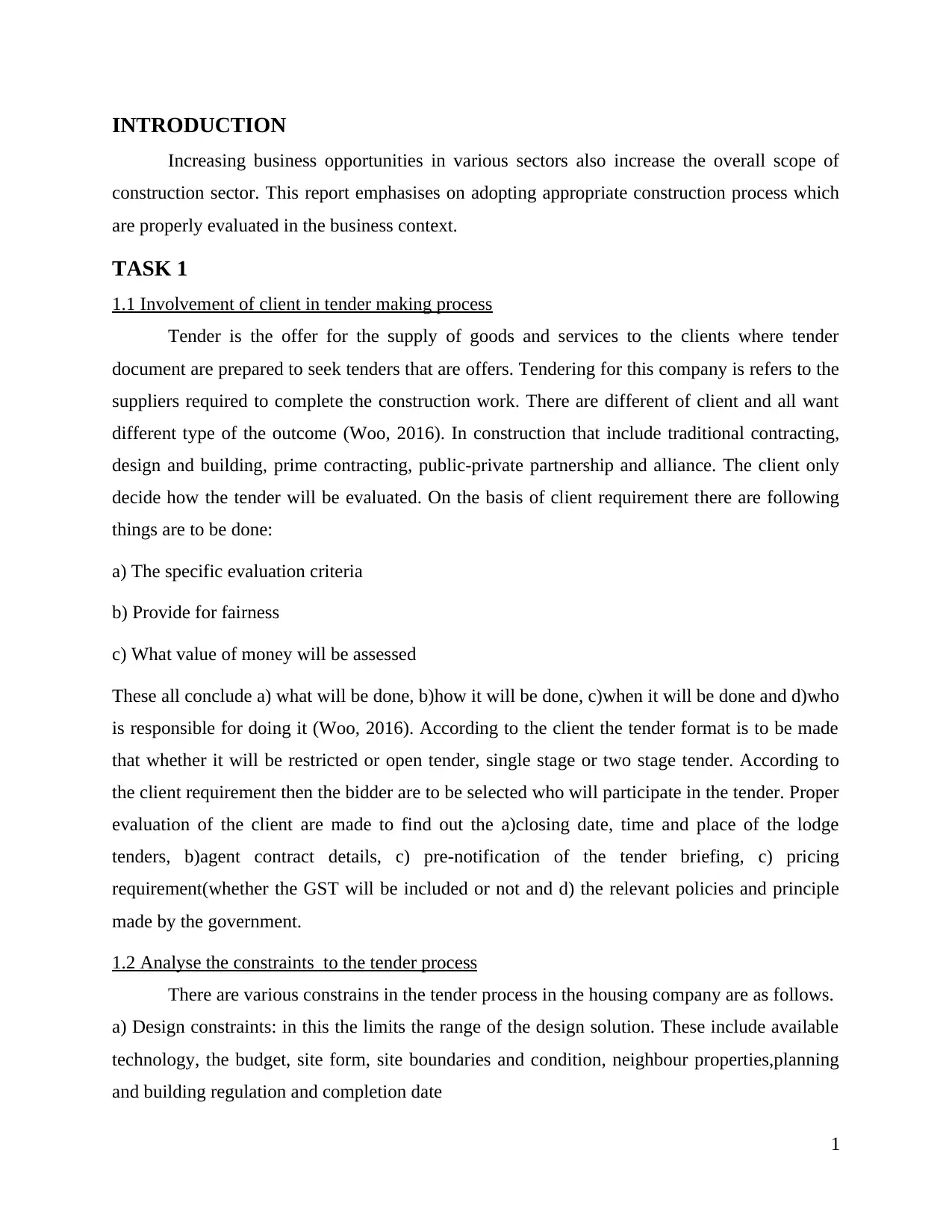
INTRODUCTION
Increasing business opportunities in various sectors also increase the overall scope of
construction sector. This report emphasises on adopting appropriate construction process which
are properly evaluated in the business context.
TASK 1
1.1 Involvement of client in tender making process
Tender is the offer for the supply of goods and services to the clients where tender
document are prepared to seek tenders that are offers. Tendering for this company is refers to the
suppliers required to complete the construction work. There are different of client and all want
different type of the outcome (Woo, 2016). In construction that include traditional contracting,
design and building, prime contracting, public-private partnership and alliance. The client only
decide how the tender will be evaluated. On the basis of client requirement there are following
things are to be done:
a) The specific evaluation criteria
b) Provide for fairness
c) What value of money will be assessed
These all conclude a) what will be done, b)how it will be done, c)when it will be done and d)who
is responsible for doing it (Woo, 2016). According to the client the tender format is to be made
that whether it will be restricted or open tender, single stage or two stage tender. According to
the client requirement then the bidder are to be selected who will participate in the tender. Proper
evaluation of the client are made to find out the a)closing date, time and place of the lodge
tenders, b)agent contract details, c) pre-notification of the tender briefing, c) pricing
requirement(whether the GST will be included or not and d) the relevant policies and principle
made by the government.
1.2 Analyse the constraints to the tender process
There are various constrains in the tender process in the housing company are as follows.
a) Design constraints: in this the limits the range of the design solution. These include available
technology, the budget, site form, site boundaries and condition, neighbour properties,planning
and building regulation and completion date
1
Increasing business opportunities in various sectors also increase the overall scope of
construction sector. This report emphasises on adopting appropriate construction process which
are properly evaluated in the business context.
TASK 1
1.1 Involvement of client in tender making process
Tender is the offer for the supply of goods and services to the clients where tender
document are prepared to seek tenders that are offers. Tendering for this company is refers to the
suppliers required to complete the construction work. There are different of client and all want
different type of the outcome (Woo, 2016). In construction that include traditional contracting,
design and building, prime contracting, public-private partnership and alliance. The client only
decide how the tender will be evaluated. On the basis of client requirement there are following
things are to be done:
a) The specific evaluation criteria
b) Provide for fairness
c) What value of money will be assessed
These all conclude a) what will be done, b)how it will be done, c)when it will be done and d)who
is responsible for doing it (Woo, 2016). According to the client the tender format is to be made
that whether it will be restricted or open tender, single stage or two stage tender. According to
the client requirement then the bidder are to be selected who will participate in the tender. Proper
evaluation of the client are made to find out the a)closing date, time and place of the lodge
tenders, b)agent contract details, c) pre-notification of the tender briefing, c) pricing
requirement(whether the GST will be included or not and d) the relevant policies and principle
made by the government.
1.2 Analyse the constraints to the tender process
There are various constrains in the tender process in the housing company are as follows.
a) Design constraints: in this the limits the range of the design solution. These include available
technology, the budget, site form, site boundaries and condition, neighbour properties,planning
and building regulation and completion date
1
⊘ This is a preview!⊘
Do you want full access?
Subscribe today to unlock all pages.

Trusted by 1+ million students worldwide
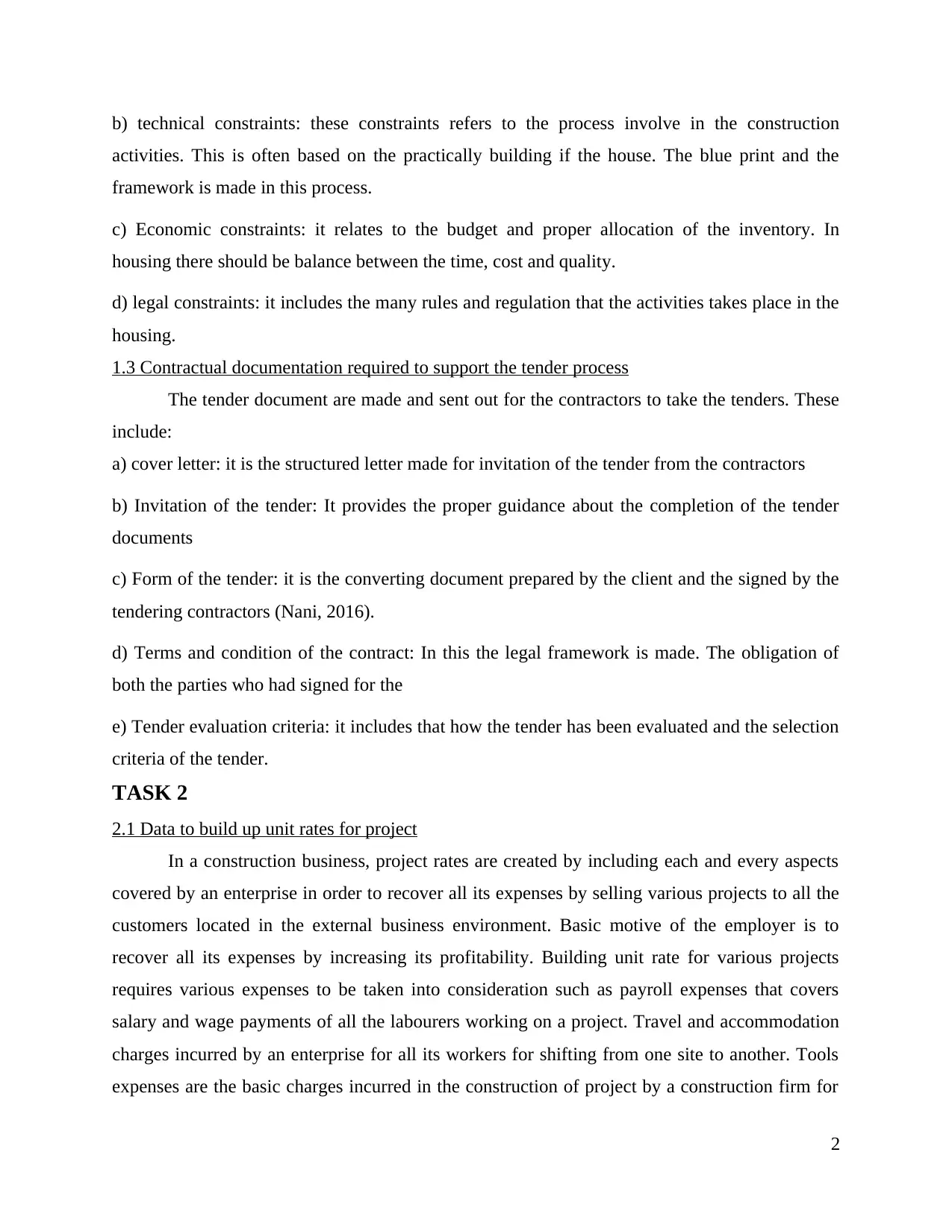
b) technical constraints: these constraints refers to the process involve in the construction
activities. This is often based on the practically building if the house. The blue print and the
framework is made in this process.
c) Economic constraints: it relates to the budget and proper allocation of the inventory. In
housing there should be balance between the time, cost and quality.
d) legal constraints: it includes the many rules and regulation that the activities takes place in the
housing.
1.3 Contractual documentation required to support the tender process
The tender document are made and sent out for the contractors to take the tenders. These
include:
a) cover letter: it is the structured letter made for invitation of the tender from the contractors
b) Invitation of the tender: It provides the proper guidance about the completion of the tender
documents
c) Form of the tender: it is the converting document prepared by the client and the signed by the
tendering contractors (Nani, 2016).
d) Terms and condition of the contract: In this the legal framework is made. The obligation of
both the parties who had signed for the
e) Tender evaluation criteria: it includes that how the tender has been evaluated and the selection
criteria of the tender.
TASK 2
2.1 Data to build up unit rates for project
In a construction business, project rates are created by including each and every aspects
covered by an enterprise in order to recover all its expenses by selling various projects to all the
customers located in the external business environment. Basic motive of the employer is to
recover all its expenses by increasing its profitability. Building unit rate for various projects
requires various expenses to be taken into consideration such as payroll expenses that covers
salary and wage payments of all the labourers working on a project. Travel and accommodation
charges incurred by an enterprise for all its workers for shifting from one site to another. Tools
expenses are the basic charges incurred in the construction of project by a construction firm for
2
activities. This is often based on the practically building if the house. The blue print and the
framework is made in this process.
c) Economic constraints: it relates to the budget and proper allocation of the inventory. In
housing there should be balance between the time, cost and quality.
d) legal constraints: it includes the many rules and regulation that the activities takes place in the
housing.
1.3 Contractual documentation required to support the tender process
The tender document are made and sent out for the contractors to take the tenders. These
include:
a) cover letter: it is the structured letter made for invitation of the tender from the contractors
b) Invitation of the tender: It provides the proper guidance about the completion of the tender
documents
c) Form of the tender: it is the converting document prepared by the client and the signed by the
tendering contractors (Nani, 2016).
d) Terms and condition of the contract: In this the legal framework is made. The obligation of
both the parties who had signed for the
e) Tender evaluation criteria: it includes that how the tender has been evaluated and the selection
criteria of the tender.
TASK 2
2.1 Data to build up unit rates for project
In a construction business, project rates are created by including each and every aspects
covered by an enterprise in order to recover all its expenses by selling various projects to all the
customers located in the external business environment. Basic motive of the employer is to
recover all its expenses by increasing its profitability. Building unit rate for various projects
requires various expenses to be taken into consideration such as payroll expenses that covers
salary and wage payments of all the labourers working on a project. Travel and accommodation
charges incurred by an enterprise for all its workers for shifting from one site to another. Tools
expenses are the basic charges incurred in the construction of project by a construction firm for
2
Paraphrase This Document
Need a fresh take? Get an instant paraphrase of this document with our AI Paraphraser
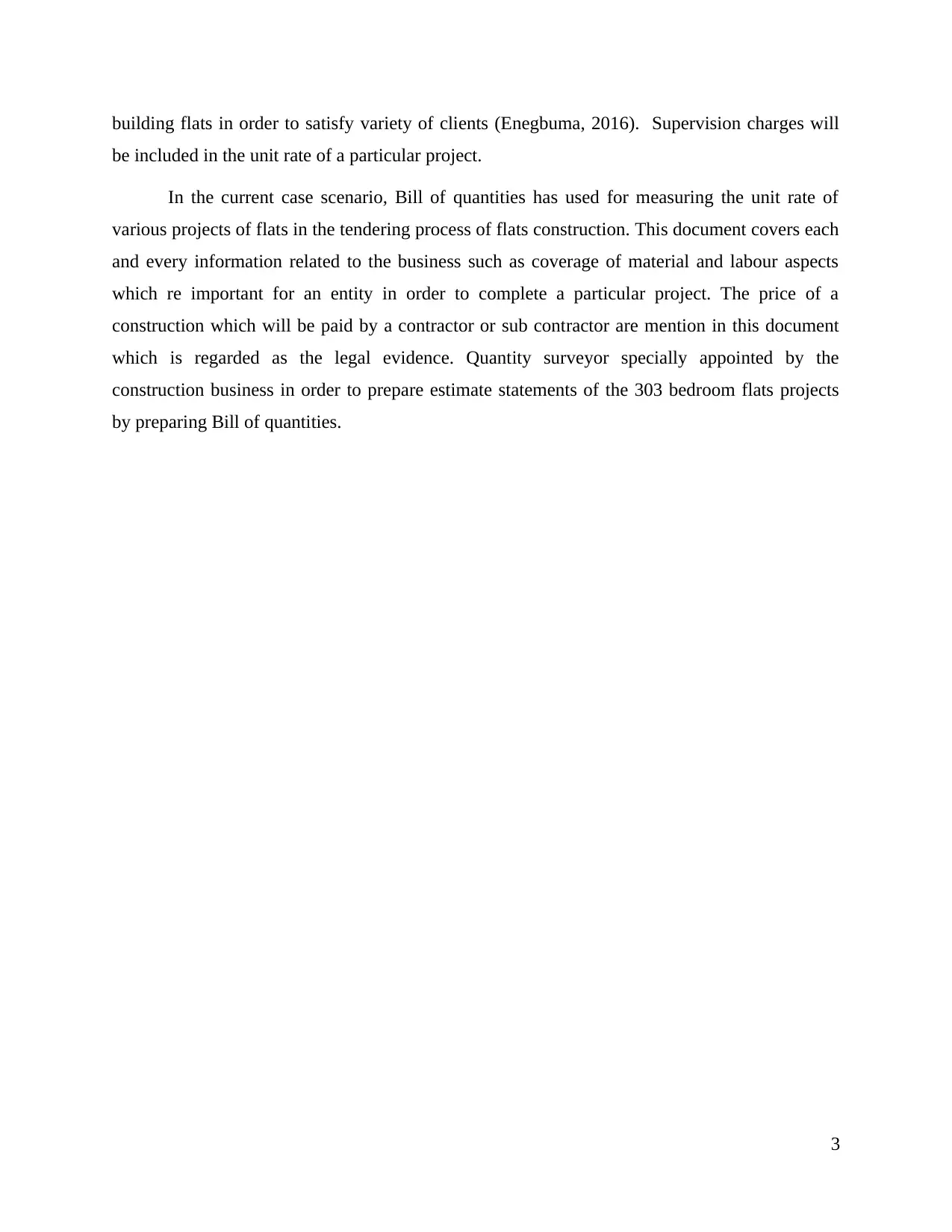
building flats in order to satisfy variety of clients (Enegbuma, 2016). Supervision charges will
be included in the unit rate of a particular project.
In the current case scenario, Bill of quantities has used for measuring the unit rate of
various projects of flats in the tendering process of flats construction. This document covers each
and every information related to the business such as coverage of material and labour aspects
which re important for an entity in order to complete a particular project. The price of a
construction which will be paid by a contractor or sub contractor are mention in this document
which is regarded as the legal evidence. Quantity surveyor specially appointed by the
construction business in order to prepare estimate statements of the 303 bedroom flats projects
by preparing Bill of quantities.
3
be included in the unit rate of a particular project.
In the current case scenario, Bill of quantities has used for measuring the unit rate of
various projects of flats in the tendering process of flats construction. This document covers each
and every information related to the business such as coverage of material and labour aspects
which re important for an entity in order to complete a particular project. The price of a
construction which will be paid by a contractor or sub contractor are mention in this document
which is regarded as the legal evidence. Quantity surveyor specially appointed by the
construction business in order to prepare estimate statements of the 303 bedroom flats projects
by preparing Bill of quantities.
3
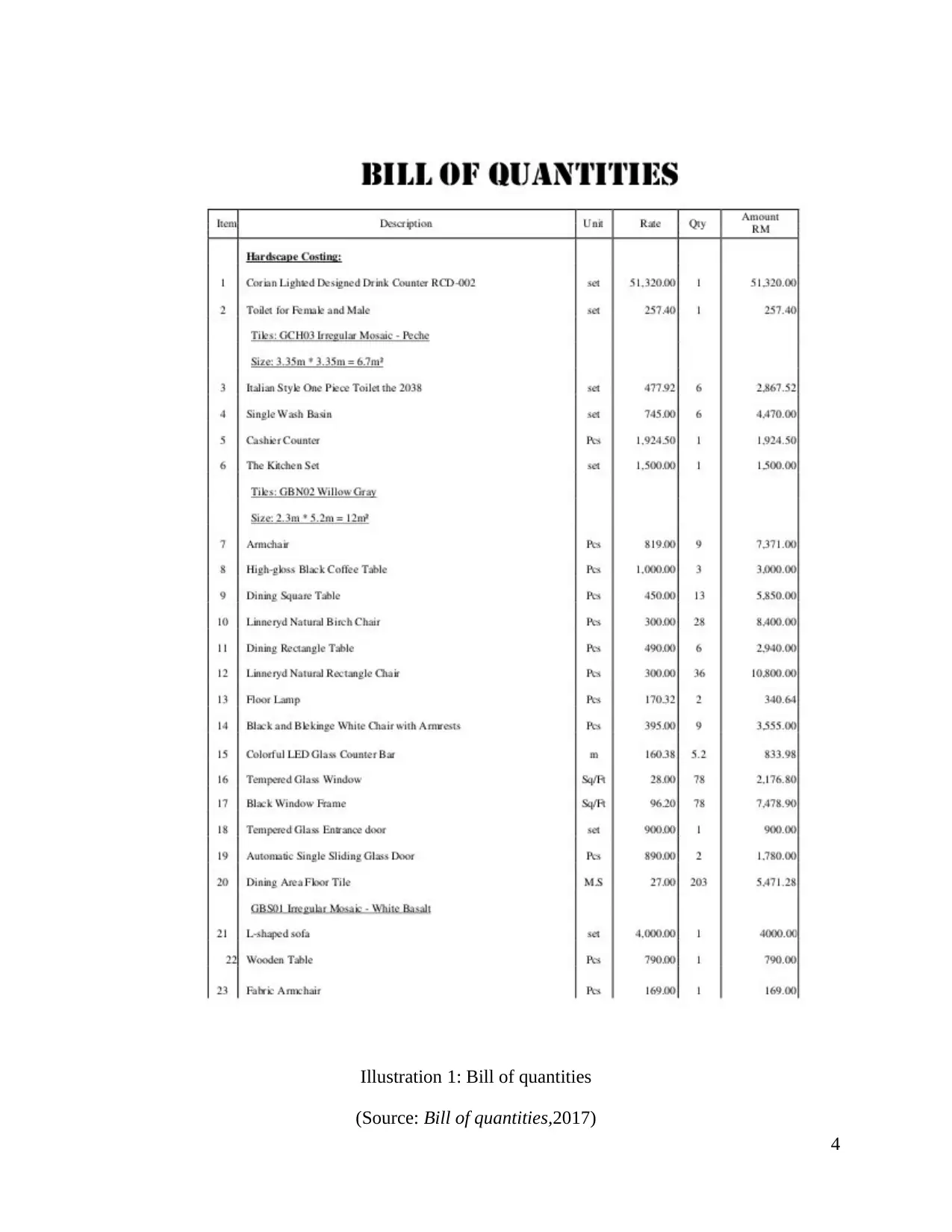
Illustration 1: Bill of quantities
(Source: Bill of quantities,2017)
4
(Source: Bill of quantities,2017)
4
⊘ This is a preview!⊘
Do you want full access?
Subscribe today to unlock all pages.

Trusted by 1+ million students worldwide
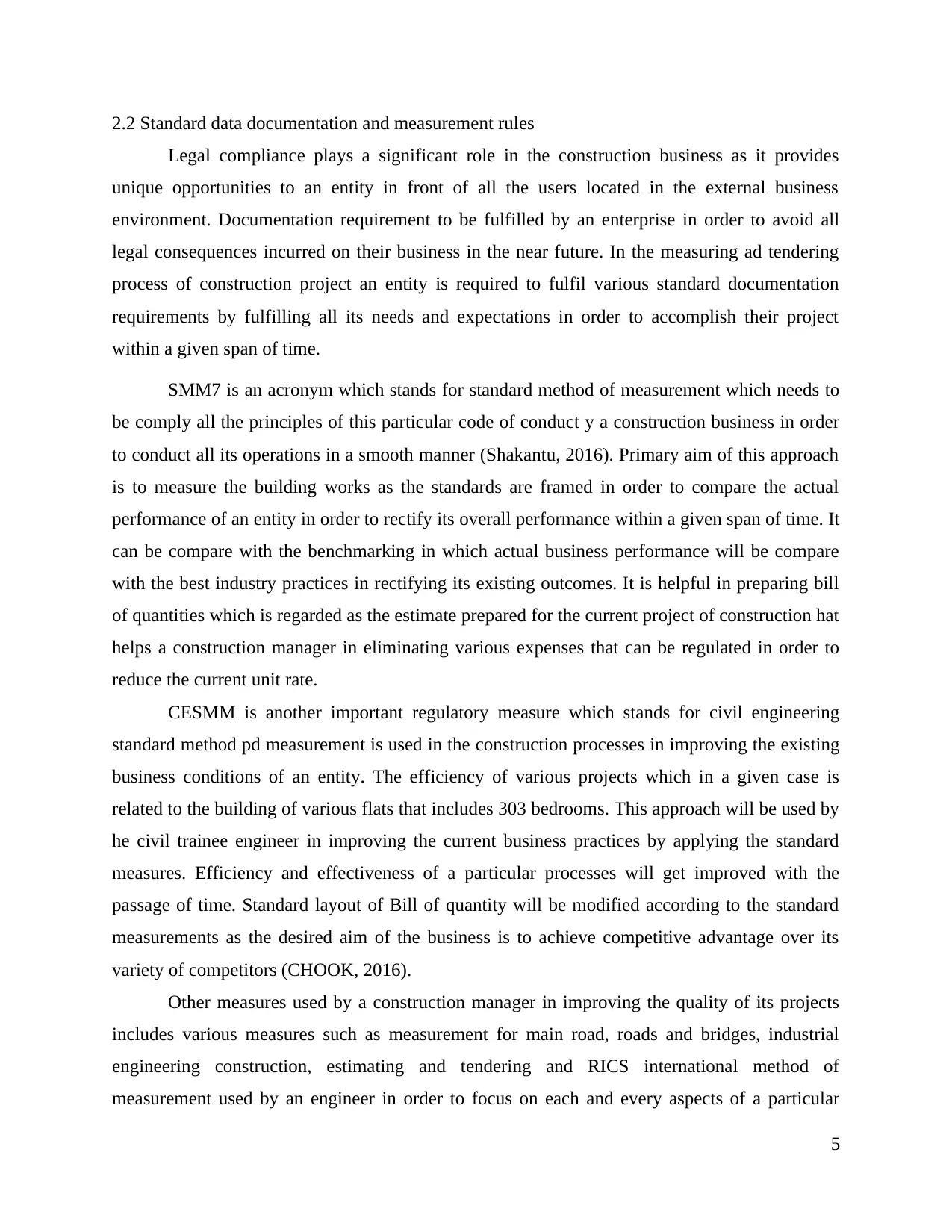
2.2 Standard data documentation and measurement rules
Legal compliance plays a significant role in the construction business as it provides
unique opportunities to an entity in front of all the users located in the external business
environment. Documentation requirement to be fulfilled by an enterprise in order to avoid all
legal consequences incurred on their business in the near future. In the measuring ad tendering
process of construction project an entity is required to fulfil various standard documentation
requirements by fulfilling all its needs and expectations in order to accomplish their project
within a given span of time.
SMM7 is an acronym which stands for standard method of measurement which needs to
be comply all the principles of this particular code of conduct y a construction business in order
to conduct all its operations in a smooth manner (Shakantu, 2016). Primary aim of this approach
is to measure the building works as the standards are framed in order to compare the actual
performance of an entity in order to rectify its overall performance within a given span of time. It
can be compare with the benchmarking in which actual business performance will be compare
with the best industry practices in rectifying its existing outcomes. It is helpful in preparing bill
of quantities which is regarded as the estimate prepared for the current project of construction hat
helps a construction manager in eliminating various expenses that can be regulated in order to
reduce the current unit rate.
CESMM is another important regulatory measure which stands for civil engineering
standard method pd measurement is used in the construction processes in improving the existing
business conditions of an entity. The efficiency of various projects which in a given case is
related to the building of various flats that includes 303 bedrooms. This approach will be used by
he civil trainee engineer in improving the current business practices by applying the standard
measures. Efficiency and effectiveness of a particular processes will get improved with the
passage of time. Standard layout of Bill of quantity will be modified according to the standard
measurements as the desired aim of the business is to achieve competitive advantage over its
variety of competitors (CHOOK, 2016).
Other measures used by a construction manager in improving the quality of its projects
includes various measures such as measurement for main road, roads and bridges, industrial
engineering construction, estimating and tendering and RICS international method of
measurement used by an engineer in order to focus on each and every aspects of a particular
5
Legal compliance plays a significant role in the construction business as it provides
unique opportunities to an entity in front of all the users located in the external business
environment. Documentation requirement to be fulfilled by an enterprise in order to avoid all
legal consequences incurred on their business in the near future. In the measuring ad tendering
process of construction project an entity is required to fulfil various standard documentation
requirements by fulfilling all its needs and expectations in order to accomplish their project
within a given span of time.
SMM7 is an acronym which stands for standard method of measurement which needs to
be comply all the principles of this particular code of conduct y a construction business in order
to conduct all its operations in a smooth manner (Shakantu, 2016). Primary aim of this approach
is to measure the building works as the standards are framed in order to compare the actual
performance of an entity in order to rectify its overall performance within a given span of time. It
can be compare with the benchmarking in which actual business performance will be compare
with the best industry practices in rectifying its existing outcomes. It is helpful in preparing bill
of quantities which is regarded as the estimate prepared for the current project of construction hat
helps a construction manager in eliminating various expenses that can be regulated in order to
reduce the current unit rate.
CESMM is another important regulatory measure which stands for civil engineering
standard method pd measurement is used in the construction processes in improving the existing
business conditions of an entity. The efficiency of various projects which in a given case is
related to the building of various flats that includes 303 bedrooms. This approach will be used by
he civil trainee engineer in improving the current business practices by applying the standard
measures. Efficiency and effectiveness of a particular processes will get improved with the
passage of time. Standard layout of Bill of quantity will be modified according to the standard
measurements as the desired aim of the business is to achieve competitive advantage over its
variety of competitors (CHOOK, 2016).
Other measures used by a construction manager in improving the quality of its projects
includes various measures such as measurement for main road, roads and bridges, industrial
engineering construction, estimating and tendering and RICS international method of
measurement used by an engineer in order to focus on each and every aspects of a particular
5
Paraphrase This Document
Need a fresh take? Get an instant paraphrase of this document with our AI Paraphraser
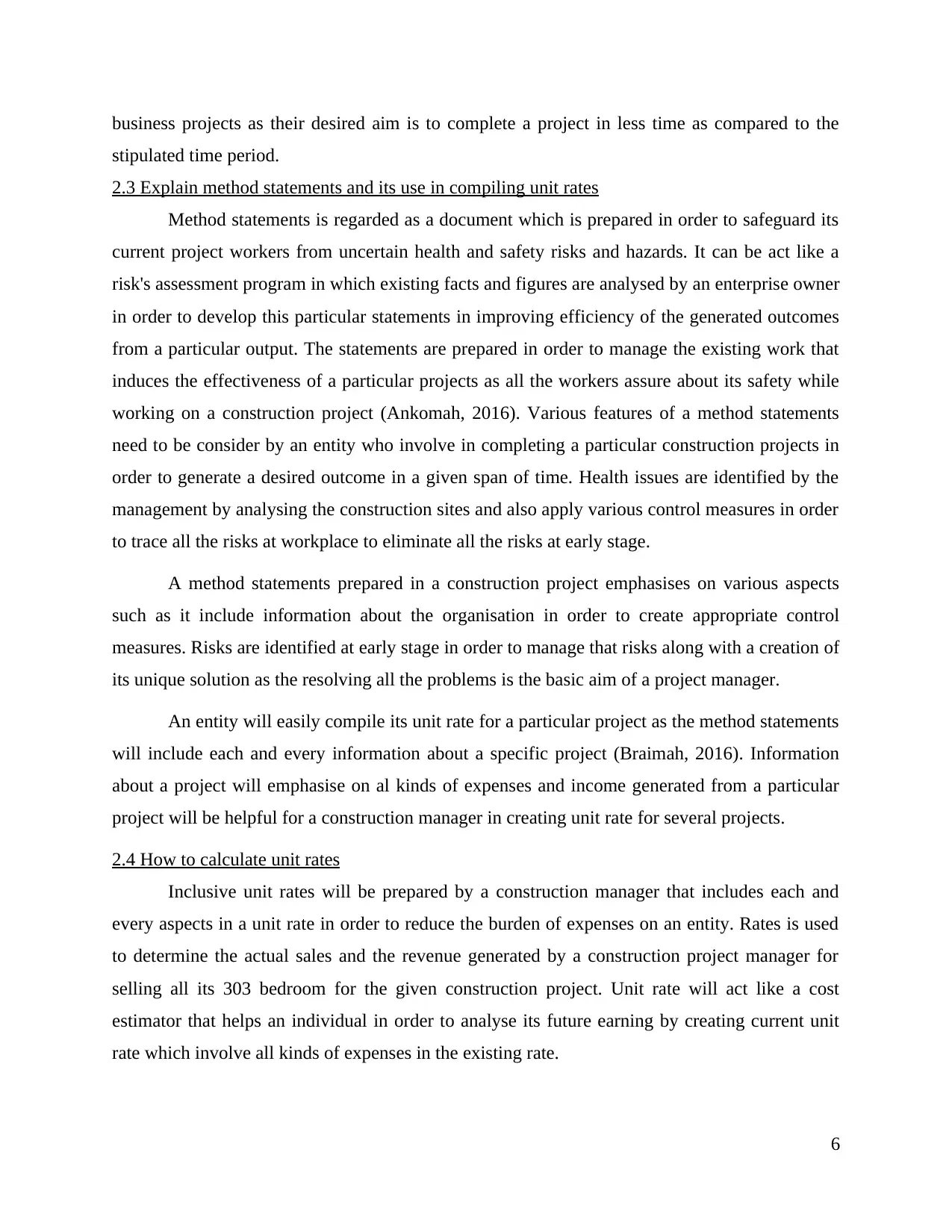
business projects as their desired aim is to complete a project in less time as compared to the
stipulated time period.
2.3 Explain method statements and its use in compiling unit rates
Method statements is regarded as a document which is prepared in order to safeguard its
current project workers from uncertain health and safety risks and hazards. It can be act like a
risk's assessment program in which existing facts and figures are analysed by an enterprise owner
in order to develop this particular statements in improving efficiency of the generated outcomes
from a particular output. The statements are prepared in order to manage the existing work that
induces the effectiveness of a particular projects as all the workers assure about its safety while
working on a construction project (Ankomah, 2016). Various features of a method statements
need to be consider by an entity who involve in completing a particular construction projects in
order to generate a desired outcome in a given span of time. Health issues are identified by the
management by analysing the construction sites and also apply various control measures in order
to trace all the risks at workplace to eliminate all the risks at early stage.
A method statements prepared in a construction project emphasises on various aspects
such as it include information about the organisation in order to create appropriate control
measures. Risks are identified at early stage in order to manage that risks along with a creation of
its unique solution as the resolving all the problems is the basic aim of a project manager.
An entity will easily compile its unit rate for a particular project as the method statements
will include each and every information about a specific project (Braimah, 2016). Information
about a project will emphasise on al kinds of expenses and income generated from a particular
project will be helpful for a construction manager in creating unit rate for several projects.
2.4 How to calculate unit rates
Inclusive unit rates will be prepared by a construction manager that includes each and
every aspects in a unit rate in order to reduce the burden of expenses on an entity. Rates is used
to determine the actual sales and the revenue generated by a construction project manager for
selling all its 303 bedroom for the given construction project. Unit rate will act like a cost
estimator that helps an individual in order to analyse its future earning by creating current unit
rate which involve all kinds of expenses in the existing rate.
6
stipulated time period.
2.3 Explain method statements and its use in compiling unit rates
Method statements is regarded as a document which is prepared in order to safeguard its
current project workers from uncertain health and safety risks and hazards. It can be act like a
risk's assessment program in which existing facts and figures are analysed by an enterprise owner
in order to develop this particular statements in improving efficiency of the generated outcomes
from a particular output. The statements are prepared in order to manage the existing work that
induces the effectiveness of a particular projects as all the workers assure about its safety while
working on a construction project (Ankomah, 2016). Various features of a method statements
need to be consider by an entity who involve in completing a particular construction projects in
order to generate a desired outcome in a given span of time. Health issues are identified by the
management by analysing the construction sites and also apply various control measures in order
to trace all the risks at workplace to eliminate all the risks at early stage.
A method statements prepared in a construction project emphasises on various aspects
such as it include information about the organisation in order to create appropriate control
measures. Risks are identified at early stage in order to manage that risks along with a creation of
its unique solution as the resolving all the problems is the basic aim of a project manager.
An entity will easily compile its unit rate for a particular project as the method statements
will include each and every information about a specific project (Braimah, 2016). Information
about a project will emphasise on al kinds of expenses and income generated from a particular
project will be helpful for a construction manager in creating unit rate for several projects.
2.4 How to calculate unit rates
Inclusive unit rates will be prepared by a construction manager that includes each and
every aspects in a unit rate in order to reduce the burden of expenses on an entity. Rates is used
to determine the actual sales and the revenue generated by a construction project manager for
selling all its 303 bedroom for the given construction project. Unit rate will act like a cost
estimator that helps an individual in order to analyse its future earning by creating current unit
rate which involve all kinds of expenses in the existing rate.
6
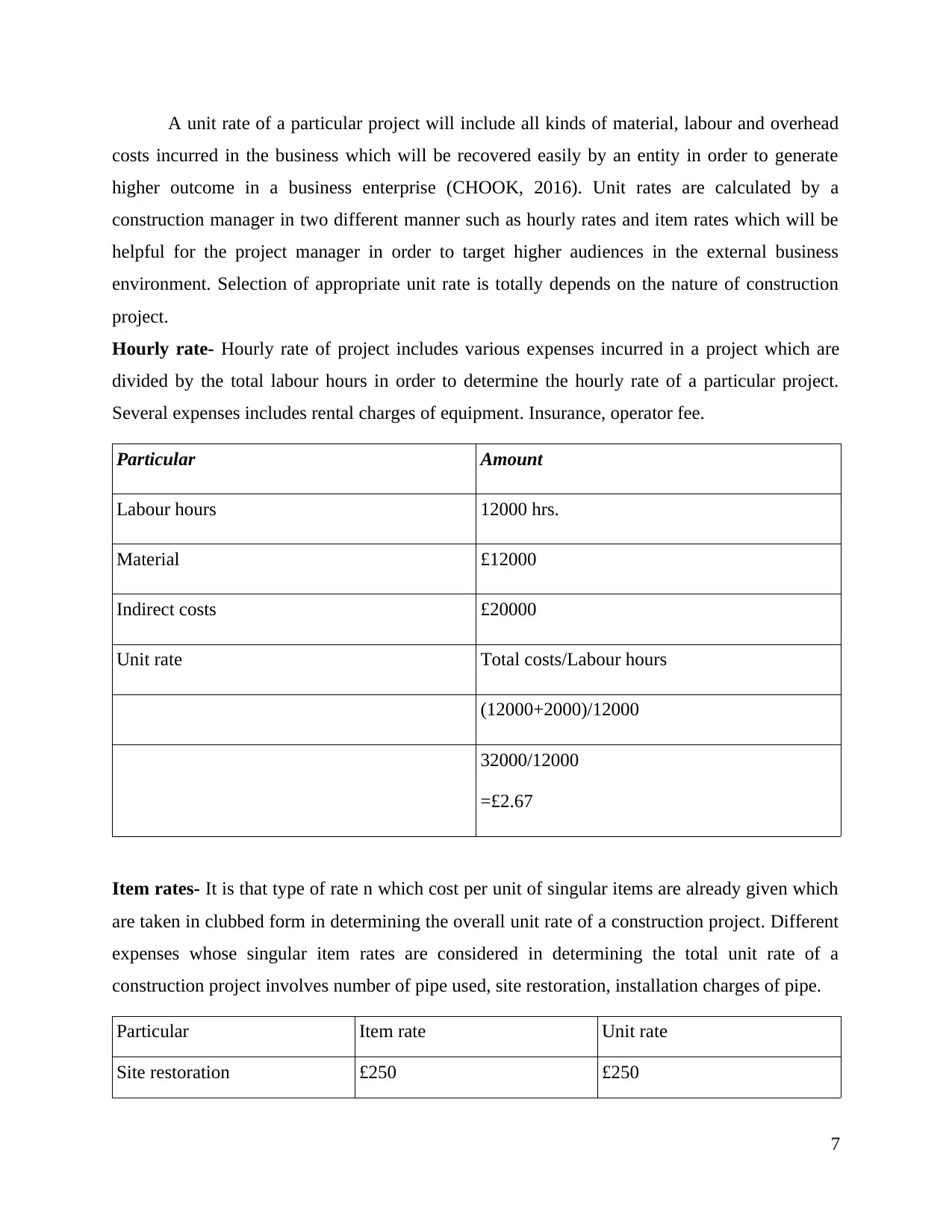
A unit rate of a particular project will include all kinds of material, labour and overhead
costs incurred in the business which will be recovered easily by an entity in order to generate
higher outcome in a business enterprise (CHOOK, 2016). Unit rates are calculated by a
construction manager in two different manner such as hourly rates and item rates which will be
helpful for the project manager in order to target higher audiences in the external business
environment. Selection of appropriate unit rate is totally depends on the nature of construction
project.
Hourly rate- Hourly rate of project includes various expenses incurred in a project which are
divided by the total labour hours in order to determine the hourly rate of a particular project.
Several expenses includes rental charges of equipment. Insurance, operator fee.
Particular Amount
Labour hours 12000 hrs.
Material £12000
Indirect costs £20000
Unit rate Total costs/Labour hours
(12000+2000)/12000
32000/12000
=£2.67
Item rates- It is that type of rate n which cost per unit of singular items are already given which
are taken in clubbed form in determining the overall unit rate of a construction project. Different
expenses whose singular item rates are considered in determining the total unit rate of a
construction project involves number of pipe used, site restoration, installation charges of pipe.
Particular Item rate Unit rate
Site restoration £250 £250
7
costs incurred in the business which will be recovered easily by an entity in order to generate
higher outcome in a business enterprise (CHOOK, 2016). Unit rates are calculated by a
construction manager in two different manner such as hourly rates and item rates which will be
helpful for the project manager in order to target higher audiences in the external business
environment. Selection of appropriate unit rate is totally depends on the nature of construction
project.
Hourly rate- Hourly rate of project includes various expenses incurred in a project which are
divided by the total labour hours in order to determine the hourly rate of a particular project.
Several expenses includes rental charges of equipment. Insurance, operator fee.
Particular Amount
Labour hours 12000 hrs.
Material £12000
Indirect costs £20000
Unit rate Total costs/Labour hours
(12000+2000)/12000
32000/12000
=£2.67
Item rates- It is that type of rate n which cost per unit of singular items are already given which
are taken in clubbed form in determining the overall unit rate of a construction project. Different
expenses whose singular item rates are considered in determining the total unit rate of a
construction project involves number of pipe used, site restoration, installation charges of pipe.
Particular Item rate Unit rate
Site restoration £250 £250
7
⊘ This is a preview!⊘
Do you want full access?
Subscribe today to unlock all pages.

Trusted by 1+ million students worldwide
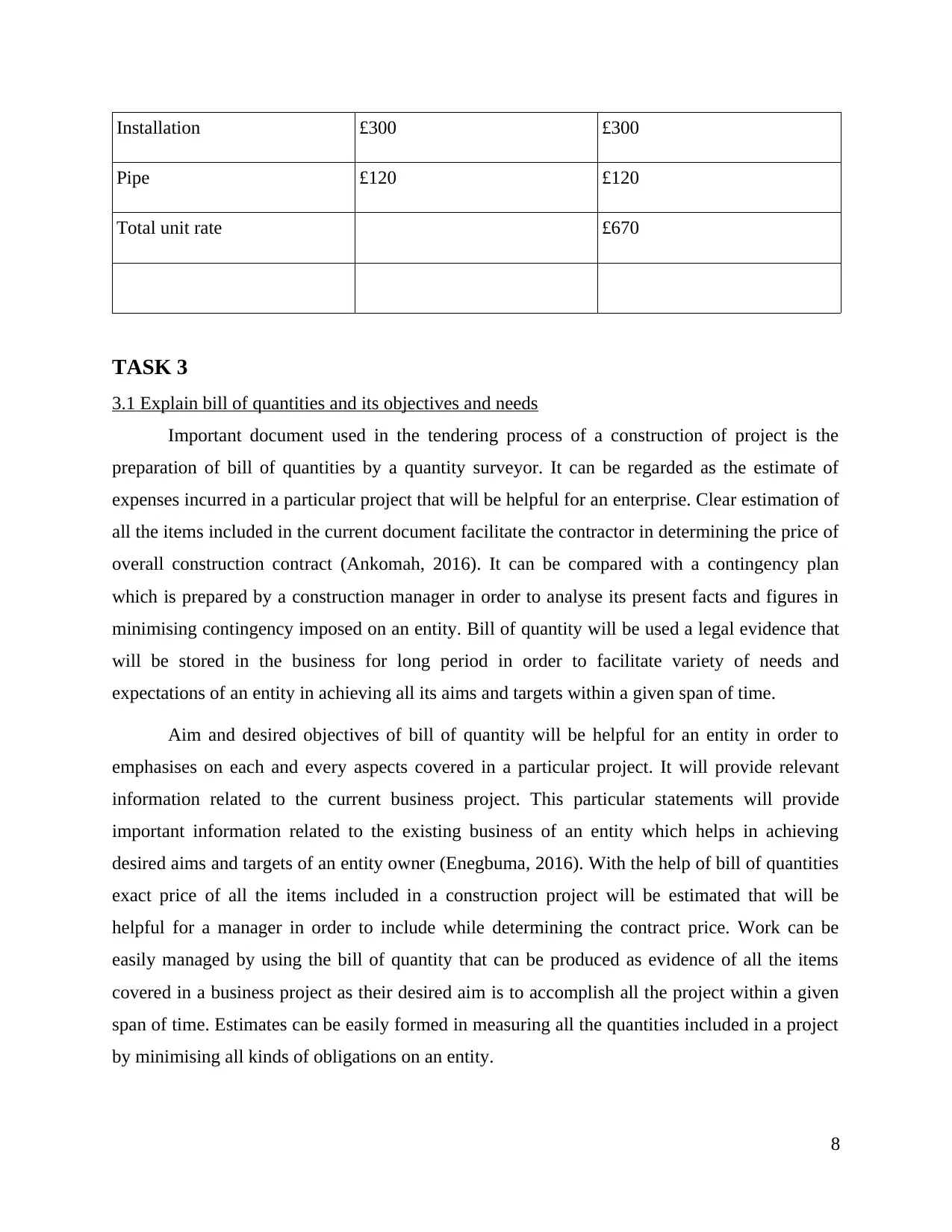
Installation £300 £300
Pipe £120 £120
Total unit rate £670
TASK 3
3.1 Explain bill of quantities and its objectives and needs
Important document used in the tendering process of a construction of project is the
preparation of bill of quantities by a quantity surveyor. It can be regarded as the estimate of
expenses incurred in a particular project that will be helpful for an enterprise. Clear estimation of
all the items included in the current document facilitate the contractor in determining the price of
overall construction contract (Ankomah, 2016). It can be compared with a contingency plan
which is prepared by a construction manager in order to analyse its present facts and figures in
minimising contingency imposed on an entity. Bill of quantity will be used a legal evidence that
will be stored in the business for long period in order to facilitate variety of needs and
expectations of an entity in achieving all its aims and targets within a given span of time.
Aim and desired objectives of bill of quantity will be helpful for an entity in order to
emphasises on each and every aspects covered in a particular project. It will provide relevant
information related to the current business project. This particular statements will provide
important information related to the existing business of an entity which helps in achieving
desired aims and targets of an entity owner (Enegbuma, 2016). With the help of bill of quantities
exact price of all the items included in a construction project will be estimated that will be
helpful for a manager in order to include while determining the contract price. Work can be
easily managed by using the bill of quantity that can be produced as evidence of all the items
covered in a business project as their desired aim is to accomplish all the project within a given
span of time. Estimates can be easily formed in measuring all the quantities included in a project
by minimising all kinds of obligations on an entity.
8
Pipe £120 £120
Total unit rate £670
TASK 3
3.1 Explain bill of quantities and its objectives and needs
Important document used in the tendering process of a construction of project is the
preparation of bill of quantities by a quantity surveyor. It can be regarded as the estimate of
expenses incurred in a particular project that will be helpful for an enterprise. Clear estimation of
all the items included in the current document facilitate the contractor in determining the price of
overall construction contract (Ankomah, 2016). It can be compared with a contingency plan
which is prepared by a construction manager in order to analyse its present facts and figures in
minimising contingency imposed on an entity. Bill of quantity will be used a legal evidence that
will be stored in the business for long period in order to facilitate variety of needs and
expectations of an entity in achieving all its aims and targets within a given span of time.
Aim and desired objectives of bill of quantity will be helpful for an entity in order to
emphasises on each and every aspects covered in a particular project. It will provide relevant
information related to the current business project. This particular statements will provide
important information related to the existing business of an entity which helps in achieving
desired aims and targets of an entity owner (Enegbuma, 2016). With the help of bill of quantities
exact price of all the items included in a construction project will be estimated that will be
helpful for a manager in order to include while determining the contract price. Work can be
easily managed by using the bill of quantity that can be produced as evidence of all the items
covered in a business project as their desired aim is to accomplish all the project within a given
span of time. Estimates can be easily formed in measuring all the quantities included in a project
by minimising all kinds of obligations on an entity.
8
Paraphrase This Document
Need a fresh take? Get an instant paraphrase of this document with our AI Paraphraser
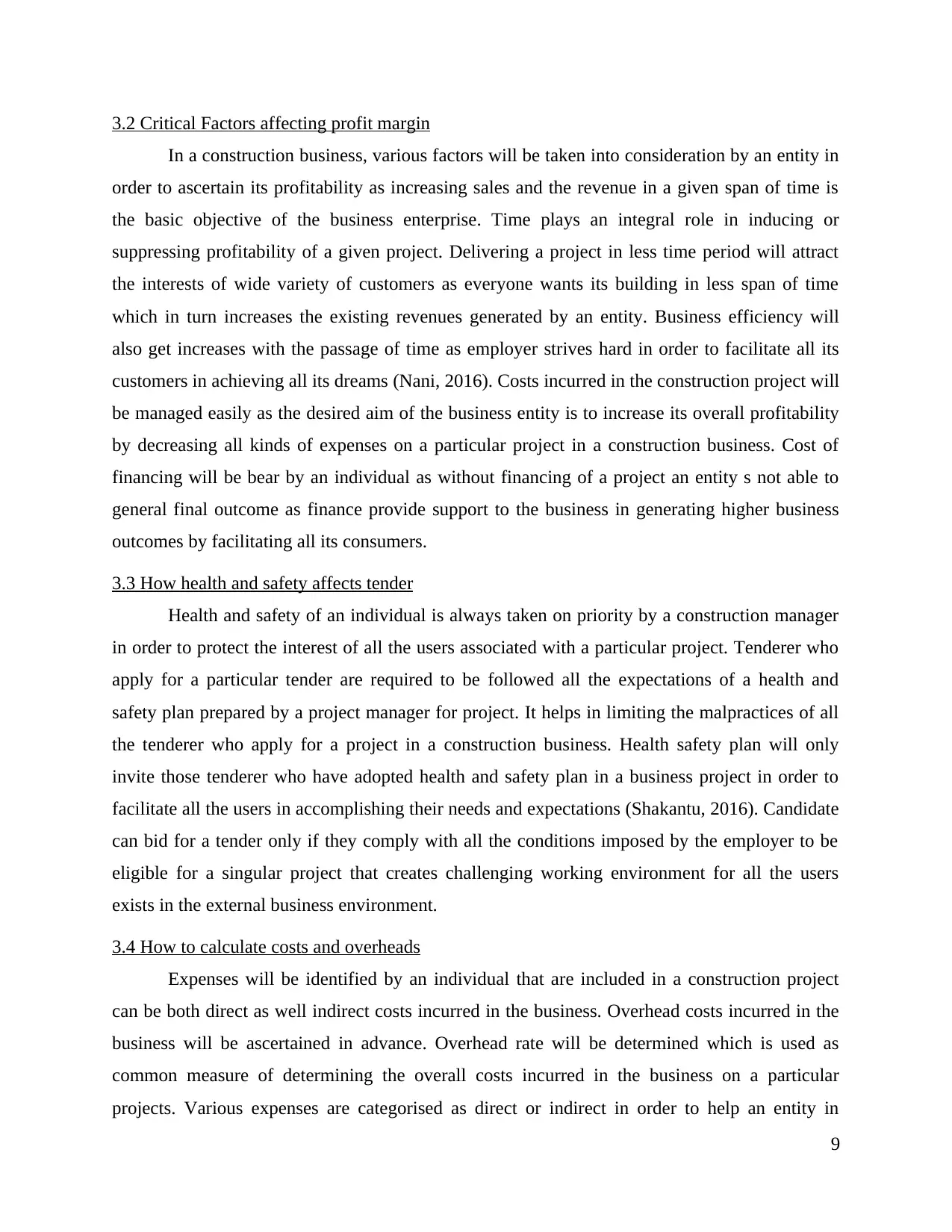
3.2 Critical Factors affecting profit margin
In a construction business, various factors will be taken into consideration by an entity in
order to ascertain its profitability as increasing sales and the revenue in a given span of time is
the basic objective of the business enterprise. Time plays an integral role in inducing or
suppressing profitability of a given project. Delivering a project in less time period will attract
the interests of wide variety of customers as everyone wants its building in less span of time
which in turn increases the existing revenues generated by an entity. Business efficiency will
also get increases with the passage of time as employer strives hard in order to facilitate all its
customers in achieving all its dreams (Nani, 2016). Costs incurred in the construction project will
be managed easily as the desired aim of the business entity is to increase its overall profitability
by decreasing all kinds of expenses on a particular project in a construction business. Cost of
financing will be bear by an individual as without financing of a project an entity s not able to
general final outcome as finance provide support to the business in generating higher business
outcomes by facilitating all its consumers.
3.3 How health and safety affects tender
Health and safety of an individual is always taken on priority by a construction manager
in order to protect the interest of all the users associated with a particular project. Tenderer who
apply for a particular tender are required to be followed all the expectations of a health and
safety plan prepared by a project manager for project. It helps in limiting the malpractices of all
the tenderer who apply for a project in a construction business. Health safety plan will only
invite those tenderer who have adopted health and safety plan in a business project in order to
facilitate all the users in accomplishing their needs and expectations (Shakantu, 2016). Candidate
can bid for a tender only if they comply with all the conditions imposed by the employer to be
eligible for a singular project that creates challenging working environment for all the users
exists in the external business environment.
3.4 How to calculate costs and overheads
Expenses will be identified by an individual that are included in a construction project
can be both direct as well indirect costs incurred in the business. Overhead costs incurred in the
business will be ascertained in advance. Overhead rate will be determined which is used as
common measure of determining the overall costs incurred in the business on a particular
projects. Various expenses are categorised as direct or indirect in order to help an entity in
9
In a construction business, various factors will be taken into consideration by an entity in
order to ascertain its profitability as increasing sales and the revenue in a given span of time is
the basic objective of the business enterprise. Time plays an integral role in inducing or
suppressing profitability of a given project. Delivering a project in less time period will attract
the interests of wide variety of customers as everyone wants its building in less span of time
which in turn increases the existing revenues generated by an entity. Business efficiency will
also get increases with the passage of time as employer strives hard in order to facilitate all its
customers in achieving all its dreams (Nani, 2016). Costs incurred in the construction project will
be managed easily as the desired aim of the business entity is to increase its overall profitability
by decreasing all kinds of expenses on a particular project in a construction business. Cost of
financing will be bear by an individual as without financing of a project an entity s not able to
general final outcome as finance provide support to the business in generating higher business
outcomes by facilitating all its consumers.
3.3 How health and safety affects tender
Health and safety of an individual is always taken on priority by a construction manager
in order to protect the interest of all the users associated with a particular project. Tenderer who
apply for a particular tender are required to be followed all the expectations of a health and
safety plan prepared by a project manager for project. It helps in limiting the malpractices of all
the tenderer who apply for a project in a construction business. Health safety plan will only
invite those tenderer who have adopted health and safety plan in a business project in order to
facilitate all the users in accomplishing their needs and expectations (Shakantu, 2016). Candidate
can bid for a tender only if they comply with all the conditions imposed by the employer to be
eligible for a singular project that creates challenging working environment for all the users
exists in the external business environment.
3.4 How to calculate costs and overheads
Expenses will be identified by an individual that are included in a construction project
can be both direct as well indirect costs incurred in the business. Overhead costs incurred in the
business will be ascertained in advance. Overhead rate will be determined which is used as
common measure of determining the overall costs incurred in the business on a particular
projects. Various expenses are categorised as direct or indirect in order to help an entity in
9
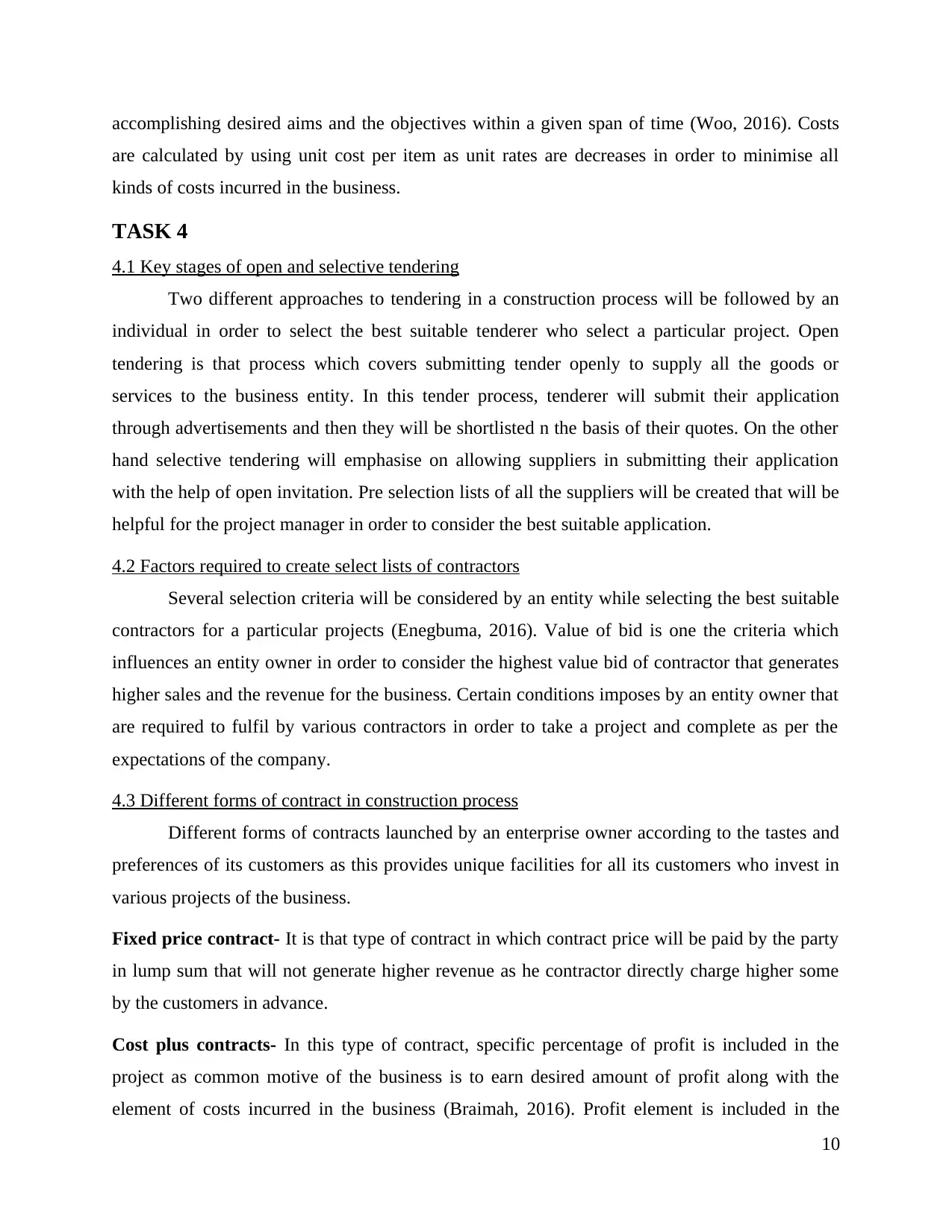
accomplishing desired aims and the objectives within a given span of time (Woo, 2016). Costs
are calculated by using unit cost per item as unit rates are decreases in order to minimise all
kinds of costs incurred in the business.
TASK 4
4.1 Key stages of open and selective tendering
Two different approaches to tendering in a construction process will be followed by an
individual in order to select the best suitable tenderer who select a particular project. Open
tendering is that process which covers submitting tender openly to supply all the goods or
services to the business entity. In this tender process, tenderer will submit their application
through advertisements and then they will be shortlisted n the basis of their quotes. On the other
hand selective tendering will emphasise on allowing suppliers in submitting their application
with the help of open invitation. Pre selection lists of all the suppliers will be created that will be
helpful for the project manager in order to consider the best suitable application.
4.2 Factors required to create select lists of contractors
Several selection criteria will be considered by an entity while selecting the best suitable
contractors for a particular projects (Enegbuma, 2016). Value of bid is one the criteria which
influences an entity owner in order to consider the highest value bid of contractor that generates
higher sales and the revenue for the business. Certain conditions imposes by an entity owner that
are required to fulfil by various contractors in order to take a project and complete as per the
expectations of the company.
4.3 Different forms of contract in construction process
Different forms of contracts launched by an enterprise owner according to the tastes and
preferences of its customers as this provides unique facilities for all its customers who invest in
various projects of the business.
Fixed price contract- It is that type of contract in which contract price will be paid by the party
in lump sum that will not generate higher revenue as he contractor directly charge higher some
by the customers in advance.
Cost plus contracts- In this type of contract, specific percentage of profit is included in the
project as common motive of the business is to earn desired amount of profit along with the
element of costs incurred in the business (Braimah, 2016). Profit element is included in the
10
are calculated by using unit cost per item as unit rates are decreases in order to minimise all
kinds of costs incurred in the business.
TASK 4
4.1 Key stages of open and selective tendering
Two different approaches to tendering in a construction process will be followed by an
individual in order to select the best suitable tenderer who select a particular project. Open
tendering is that process which covers submitting tender openly to supply all the goods or
services to the business entity. In this tender process, tenderer will submit their application
through advertisements and then they will be shortlisted n the basis of their quotes. On the other
hand selective tendering will emphasise on allowing suppliers in submitting their application
with the help of open invitation. Pre selection lists of all the suppliers will be created that will be
helpful for the project manager in order to consider the best suitable application.
4.2 Factors required to create select lists of contractors
Several selection criteria will be considered by an entity while selecting the best suitable
contractors for a particular projects (Enegbuma, 2016). Value of bid is one the criteria which
influences an entity owner in order to consider the highest value bid of contractor that generates
higher sales and the revenue for the business. Certain conditions imposes by an entity owner that
are required to fulfil by various contractors in order to take a project and complete as per the
expectations of the company.
4.3 Different forms of contract in construction process
Different forms of contracts launched by an enterprise owner according to the tastes and
preferences of its customers as this provides unique facilities for all its customers who invest in
various projects of the business.
Fixed price contract- It is that type of contract in which contract price will be paid by the party
in lump sum that will not generate higher revenue as he contractor directly charge higher some
by the customers in advance.
Cost plus contracts- In this type of contract, specific percentage of profit is included in the
project as common motive of the business is to earn desired amount of profit along with the
element of costs incurred in the business (Braimah, 2016). Profit element is included in the
10
⊘ This is a preview!⊘
Do you want full access?
Subscribe today to unlock all pages.

Trusted by 1+ million students worldwide
1 out of 15
Related Documents
Your All-in-One AI-Powered Toolkit for Academic Success.
+13062052269
info@desklib.com
Available 24*7 on WhatsApp / Email
![[object Object]](/_next/static/media/star-bottom.7253800d.svg)
Unlock your academic potential
Copyright © 2020–2025 A2Z Services. All Rights Reserved. Developed and managed by ZUCOL.





